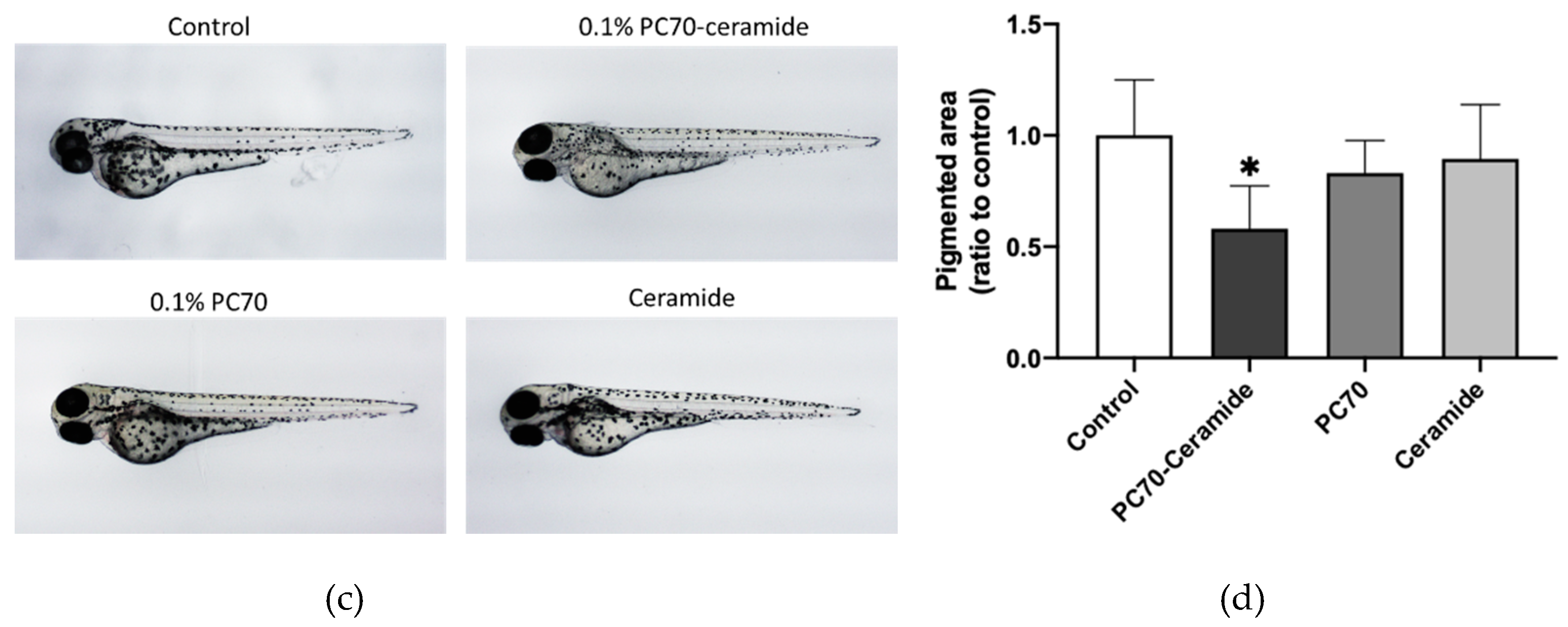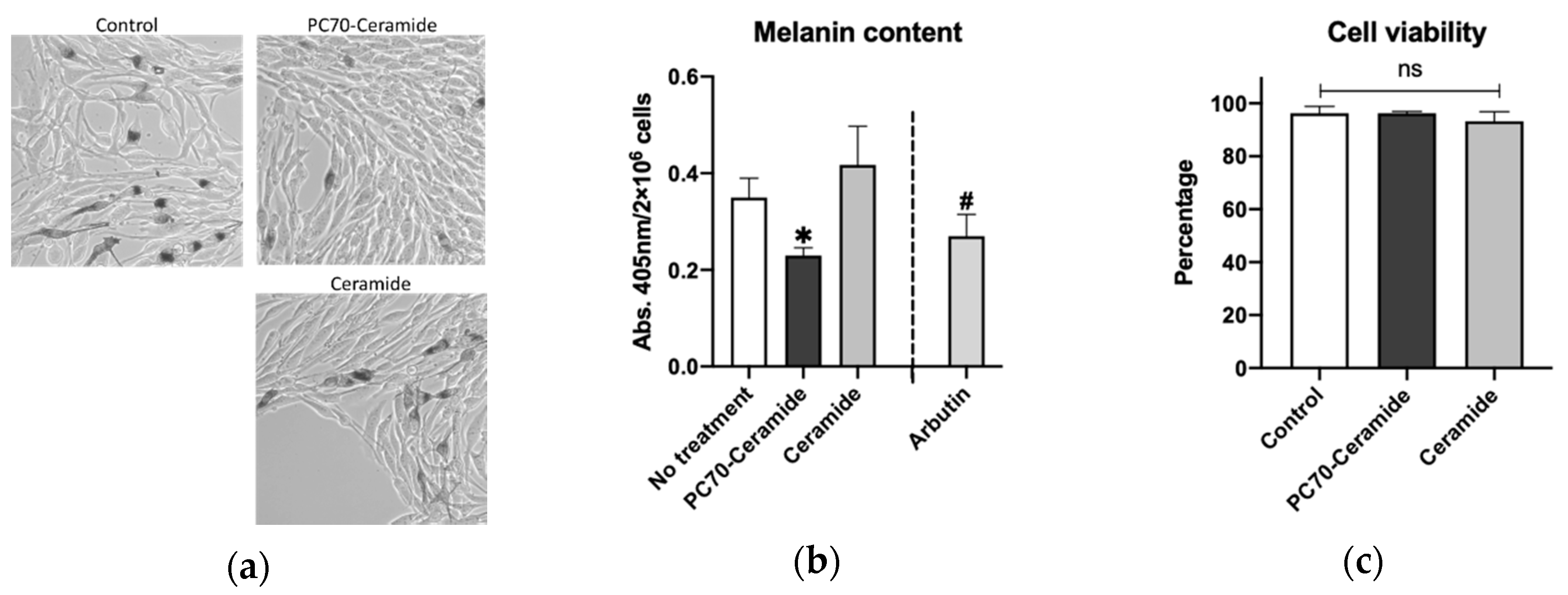Lecithin-Based Dermal Drug Delivery for Anti-Pigmentation Maize Ceramide
Abstract
1. Introduction
2. Results
2.1. PC70-Ceramide Suppresses Pigmentation in Zebrafish
2.2. Nile Red Delivery by PC70-Lecithin
2.3. Lecithin-Ceramide Treatment in Mouse Melanoma Cells
3. Discussion
3.1. PC70-Lecithin is the Safest Emulsifier for Dermal Drug Delivery in Zebrafish
3.2. PC70-Based Ceramide Delivery
4. Materials and Methods
4.1. Preparation of Lecithin Emulsion
4.2. Ethics
4.3. Zebrafish Experiment
4.4. Measurement of Pigmentation in Zebrafish Larvae
4.5. Mouse Melanoma Cells
4.6. In Vitro Pigmentation Assay
4.7. Statistics
5. Conclusions
Author Contributions
Funding
Acknowledgments
Conflicts of Interest
References
- Bikman, B.T.; Summers, S.A. Ceramides as modulators of cellular and whole-body metabolism. J. Clin. Investig. 2011, 121, 4222–4230. [Google Scholar] [CrossRef] [PubMed]
- Jayadev, S.; Liu, B.; Bielawska, A.E.; Lee, J.Y.; Nazaire, F.; Pushkareva, M.Y.; Obeid, L.; Hannun, Y.A. Role for Ceramide in Cell Cycle Arrest. J. Boil. Chem. 1995, 270, 2047–2052. [Google Scholar] [CrossRef] [PubMed]
- Hannun, Y.A. The Sphingomyelin Cycle And The 2nd Messenger Function Of Ceramide. J. Biol. Chem. 1994, 269, 3125–3128. [Google Scholar] [PubMed]
- Obeid, L.; Linardic, C.; Karolak, L.; Hannun, Y. Programmed cell death induced by ceramide. Science 1993, 259, 1769–1771. [Google Scholar] [CrossRef]
- Kim, D.-S.; Moon, S.; Chung, J.-H.; Cho, K.H.; Park, K. Ceramide Inhibits Cell Proliferation through Akt/PKB Inactivation and Decreases Melanin Synthesis in Mel?Ab Cells. Pigment. Cell Res. 2001, 14, 110–115. [Google Scholar] [CrossRef]
- Kim, D.-S.; Kim, S.-Y.; Chung, J.-H.; Kim, K.-H.; Eun, H.-C.; Park, K.-C. Delayed ERK activation by ceramide reduces melanin synthesis in human melanocytes. Cell. Signal. 2002, 14, 779–785. [Google Scholar] [CrossRef]
- Han, W.S.; Yoo, J.Y.; Youn, S.W.; Kim, D.S.; Park, K.C.; Kim, S.Y.; Kim, K.H. Effects of C2-ceramide on the Malme-3M melanoma cell line. J. Dermatol. Sci. 2002, 30, 10–19. [Google Scholar] [CrossRef]
- Kinoshita, M.; Hori, N.; Aida, K.; Sugawara, T.; Ohnishi, M. Prevention of melanin formation by yeast cerebroside in B16 mouse melanoma cells. J. Oleo Sci. 2007, 56, 645–648. [Google Scholar] [CrossRef][Green Version]
- Kelsh, R.; Schmid, B.; Eisen, J.S. Genetic Analysis of Melanophore Development in Zebrafish Embryos. Dev. Boil. 2000, 225, 277–293. [Google Scholar] [CrossRef]
- Lamason, R.; Mohideen, M.-A.P.; Mest, J.R.; Wong, A.C.; Norton, H.L.; Aros, M.C.; Jurynec, M.; Mao, X.; Humphreville, V.R.; Humbert, J.E.; et al. SLC24A5, a Putative Cation Exchanger, Affects Pigmentation in Zebrafish and Humans. Science 2005, 310, 1782–1786. [Google Scholar] [CrossRef]
- Choi, T.-Y.; Kim, J.-H.; Ko, D.H.; Kim, C.-H.; Hwang, J.-S.; Ahn, S.; Kim, S.Y.; Kim, C.-D.; Lee, J.-H.; Yoon, T.-J. Zebrafish as a new model for phenotype-based screening of melanogenic regulatory compounds. Pigment. Cell Res. 2007, 20, 120–127. [Google Scholar] [CrossRef] [PubMed]
- Lin, V.C.; Ding, H.-Y.; Tsai, P.-C.; Wu, J.-Y.; Lu, Y.-H.; Chang, T.-S. In Vitroandin VivoMelanogenesis Inhibition by Biochanin A fromTrifolium pratense. Biosci. Biotechnol. Biochem. 2011, 75, 914–918. [Google Scholar] [CrossRef]
- Kumar, K.J.S.; Vani, M.G.; Wang, S.-Y.; Liao, J.-W.; Hsu, L.-S.; Yang, H.-L.; Hseu, Y.-C. In vitro and in vivo studies disclosed the depigmenting effects of gallic acid: A novel skin lightening agent for hyperpigmentary skin diseases. BioFactors 2013, 39, 259–270. [Google Scholar] [CrossRef] [PubMed]
- Chen, W.-C.; Tseng, T.-S.; Hsiao, N.-W.; Lin, Y.-L.; Wen, Z.-H.; Tsai, C.-C.; Lee, Y.-C.; Lin, H.-H.; Tsai, K.-C. Discovery of Highly Potent Tyrosinase Inhibitor, T1, with Significant Anti-Melanogenesis Ability by zebrafish in vivo Assay and Computational Molecular Modeling. Sci. Rep. 2015, 5, 7995. [Google Scholar] [CrossRef] [PubMed]
- Lee, Y.R.; Park, J.-H.; Molina, R.C.; Nam, Y.H.; Lee, Y.-G.; Na Hong, B.; Baek, N.-I.; Kang, T.H. Skin depigmenting action of silkworm (Bombyx mori L.) droppings in zebrafish. Arch. Dermatol. Res. 2018, 310, 245–253. [Google Scholar] [CrossRef] [PubMed]
- Ruyra, A.; Cano-Sarabia, M.; MacKenzie, S.; Maspoch, D.; Roher, N. A Novel Liposome-Based Nanocarrier Loaded with an LPS-dsRNA Cocktail for Fish Innate Immune System Stimulation. PLoS ONE 2013, 8, e76338. [Google Scholar] [CrossRef] [PubMed]
- Yang, J.; Shimada, Y.; Olsthoorn, R.; Snaar-Jagalska, B.E.; Spaink, H.P.; Kros, A. Application of Coiled Coil Peptides in Liposomal Anticancer Drug Delivery Using a Zebrafish Xenograft Model. ACS Nano 2016, 10, 7428–7435. [Google Scholar] [CrossRef]
- Calienni, M.N.; Cagel, M.; Montanari, J.; Moretton, M.A.; Prieto, M.J.; Chiappetta, D.A.; Alonso, S. Zebrafish (Danio rerio) model as an early stage screening tool to study the biodistribution and toxicity profile of doxorubicin-loaded mixed micelles. Toxicol. Appl. Pharmacol. 2018, 357, 106–114. [Google Scholar] [CrossRef]
- Teijeiro-Valiño, C.; Yebra-Pimentel, E.; Guerra-Varela, J.; Csaba, N.; Alonso, M.J.; Sánchez, L. Assessment of the permeability and toxicity of polymeric nanocapsules using the zebrafish model. Nanomedicine 2017, 12, 2069–2082. [Google Scholar] [CrossRef]
- Wang, F.; Wang, X.; Gao, L.; Meng, L.-Y.; Xie, J.-M.; Xiong, J.-W.; Luo, Y. Nanoparticle-mediated delivery of siRNA into zebrafish heart: a cell-level investigation on the biodistribution and gene silencing effects. Nanoscale 2019, 11, 18052–18064. [Google Scholar] [CrossRef]
- Jia, H.-R.; Zhu, Y.-X.; Duan, Q.-Y.; Chen, Z.; Wu, F.-G. Nanomaterials meet zebrafish: Toxicity evaluation and drug delivery applications. J. Control. Release 2019, 301–318. [Google Scholar] [CrossRef] [PubMed]
- Jia, H.-R.; Zhu, Y.-X.; Xu, K.-F.; Pan, G.-Y.; Liu, X.; Qiao, Y.; Wu, F.-G. Efficient cell surface labelling of live zebrafish embryos: wash-free fluorescence imaging for cellular dynamics tracking and nanotoxicity evaluation. Chem. Sci. 2019, 10, 4062–4068. [Google Scholar] [CrossRef] [PubMed]
- Huang, C.-H.; Mason, J.T. Structure and properties of mixed-chain phospholipid assemblies. Biochim. Biophys. Acta (BBA) Rev. Biomembr. 1986, 864, 423–470. [Google Scholar] [CrossRef]
- Le Ngoc, T.T.; Du Cao, V.; Nguyen, T.N.Q.; Le, T.T.H.; Tran, T.T.; Thi, T.T.H. Soy Lecithin-Derived Liposomal Delivery Systems: Surface Modification and Current Applications. Int. J. Mol. Sci. 2019, 20, 4706. [Google Scholar]
- Li, H.; Liu, B.; Ao, H.; Fu, J.; Wang, Y.; Feng, Y.; Guo, Y.; Wang, X. Soybean lecithin stabilizes disulfiram nanosuspensions with a high drug-loading content: remarkably improved antitumor efficacy. J. Nanobiotechnology 2020, 18, 1–11. [Google Scholar] [CrossRef]
- Savić, V.; Ilić, T.; Nikolić, I.; Marković, B.; Čalija, B.; Cekic, N.; Savic, S. Tacrolimus-loaded lecithin-based nanostructured lipid carrier and nanoemulsion with propylene glycol monocaprylate as a liquid lipid: Formulation characterization and assessment of dermal delivery compared to referent ointment. Int. J. Pharm. 2019, 569, 118624. [Google Scholar] [CrossRef]
- Iwashita, K.; Kobori, M.; Yamaki, K.; Tsushida, T. Flavonoids Inhibit Cell Growth and Induce Apoptosis in B16 Melanoma 4A5 Cells. Biosci. Biotechnol. Biochem. 2000, 64, 1813–1820. [Google Scholar] [CrossRef]
- Yoshimoto, T.; Yamamoto, K.; Tsuru, D. Extracellular Tyrosinase from Streptomyces Sp. KY-453: Purification and Some Enzymatic Properties1. J. Biochem. 1985, 97, 1747–1754. [Google Scholar] [CrossRef]
- Collier, H.B. FACTORS AFFECTING THE HEMOLYTIC ACTION OF "LYSOLECITHIN" UPON RABBIT ERYTHROCYTES. J. Gen. Physiol. 1952, 35, 617–628. [Google Scholar] [CrossRef] [PubMed]
- E Sobel, B.; Corr, P.B.; Robison, A.K.; A Goldstein, R.; Witkowski, F.X.; Klein, M.S. Accumulation of lysophosphoglycerides with arrhythmogenic properties in ischemic myocardium. J. Clin. Investig. 1978, 62, 546–553. [Google Scholar] [CrossRef]
- Uchida, Y.; Ogawa, T.; Ohta, M.; Kondo, M.; Takada, S.; Yamamura, M. Penetration of Lysophosphatidylcholine into the Dermis. J. Dermatol. 1991, 18, 523–527. [Google Scholar] [CrossRef]
- Borodzicz, S.; Rudnicka, L.; Mirowska-Guzel, D.; Cudnoch-Jędrzejewska, A. The role of epidermal sphingolipids in dermatologic diseases. Lipids Heal. Dis. 2016, 15, 13. [Google Scholar] [CrossRef] [PubMed]
- Li, Q.; Fang, H.; Dang, E.; Wang, G. The role of ceramides in skin homeostasis and inflammatory skin diseases. J. Dermatol. Sci. 2019, 97, 2–8. [Google Scholar] [CrossRef] [PubMed]
- Jiang, J.; Boese, M.; Turner, P.; Wang, R.K. Penetration kinetics of dimethyl sulphoxide and glycerol in dynamic optical clearing of porcine skin tissue in vitro studied by Fourier transform infrared spectroscopic imaging. J. Biomed. Opt. 2008, 13, 021105. [Google Scholar] [CrossRef]
- Fluhr, M.G.J.W. Glycerol Accelerates Recovery of Barrier Function In Vivo. Acta Derm. Venereol. 1999, 79, 418–421. [Google Scholar] [PubMed]
- Westerfield, M. The Zebrafish Book: A Guide for the Laboratory Use of Zebrafish (Danio Rerio); University of Oregon Press: Eugene, OR, USA, 2007; p. 1v. [Google Scholar]
- Zang, L.; Shimada, Y.; Hiroko, N.; Kim, Y.; Chu, D.C.; Juneja, L.R.; Kuroyanagi, J.; Nishimura, N. RNA-seq Based Transcriptome Analysis of the Anti-Obesity Effect of Green Tea Extract Using Zebrafish Obesity Models. Molecules 2019, 24, 3256. [Google Scholar] [CrossRef] [PubMed]
- Hu, F.; Lesney, P.F. The Isolation And Cytology Of Two Pigment Cell Strains From B-16 Mouse Melanomas. Cancer Res. 1964, 24, 1634–1643. [Google Scholar] [PubMed]
- Alam, B.; Ahmed, A.; Motin, A.; Kim, S.; Lee, S.-H. Attenuation of melanogenesis by Nymphaea nouchali (Burm. f) flower extract through the regulation of cAMP/CREB/MAPKs/MITF and proteasomal degradation of tyrosinase. Sci. Rep. 2018, 8, 13928. [Google Scholar] [CrossRef] [PubMed]
Sample Availability: Samples of PC70-ceramide are available from the authors. |




| Lecithin Alone | Lecithin-Ceramide | |
|---|---|---|
| PC70 | 240.8 ± 34.6 µg/mL | 533.1 ± 203.5 µg/mL (266.5 ± 101.8 µg/mL) |
| LPC70 | 3.0 ± 0.3 µg/mL | 3.4 ± 0.4 µg/mL (1.7 ± 0.2 µg/mL) |
| LPC70H | 1.1 ± 0.1 µg/mL | 2.1 ± 1.0 µg/mL (1.1 ± 0.5 µg/mL) |
© 2020 by the authors. Licensee MDPI, Basel, Switzerland. This article is an open access article distributed under the terms and conditions of the Creative Commons Attribution (CC BY) license (http://creativecommons.org/licenses/by/4.0/).
Share and Cite
Kagotani, K.; Nakayama, H.; Zang, L.; Fujimoto, Y.; Hayashi, A.; Sono, R.; Nishimura, N.; Shimada, Y. Lecithin-Based Dermal Drug Delivery for Anti-Pigmentation Maize Ceramide. Molecules 2020, 25, 1595. https://doi.org/10.3390/molecules25071595
Kagotani K, Nakayama H, Zang L, Fujimoto Y, Hayashi A, Sono R, Nishimura N, Shimada Y. Lecithin-Based Dermal Drug Delivery for Anti-Pigmentation Maize Ceramide. Molecules. 2020; 25(7):1595. https://doi.org/10.3390/molecules25071595
Chicago/Turabian StyleKagotani, Kazuhiro, Hiroko Nakayama, Liqing Zang, Yuki Fujimoto, Akihito Hayashi, Ryoji Sono, Norihiro Nishimura, and Yasuhito Shimada. 2020. "Lecithin-Based Dermal Drug Delivery for Anti-Pigmentation Maize Ceramide" Molecules 25, no. 7: 1595. https://doi.org/10.3390/molecules25071595
APA StyleKagotani, K., Nakayama, H., Zang, L., Fujimoto, Y., Hayashi, A., Sono, R., Nishimura, N., & Shimada, Y. (2020). Lecithin-Based Dermal Drug Delivery for Anti-Pigmentation Maize Ceramide. Molecules, 25(7), 1595. https://doi.org/10.3390/molecules25071595







